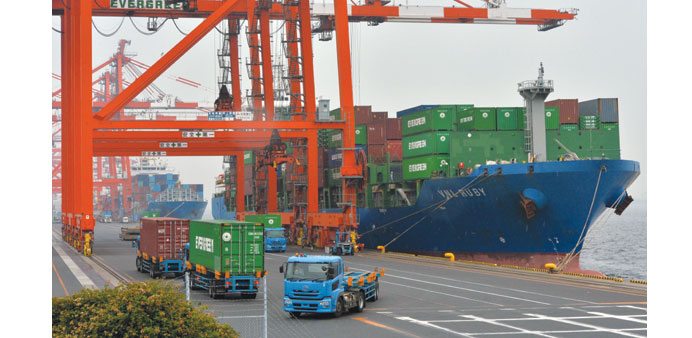Shipping containers are loaded onto an international freighter from trucks at the international cargo terminal in Tokyo. Japan’s trade deficit narrowed in May as imports turned down for the first time in a year and a half.
Reuters/Tokyo
Japan’s annual exports declined for the first time in 15 months in May as shipments to Asia and the US fell, threatening to knock the economy hard at a time when domestic consumption is being crimped by a national sales tax increase.
The data backs expectations for additional stimulus from the Bank of Japan in coming months, particularly if market confidence takes a hit as external demand proves elusive.
“If exports fail to pick up while domestic demand stagnates, that would heighten calls for the BoJ to act,” said Takeshi Minami, chief economist at Norinchukin Research Institute.
Total exports fell 2.7% May on the year, ministry of finance data showed yesterday, compared with a 1.2% drop seen by economists and a 5.1% rise in April. On a seasonally adjusted basis, exports fell 1.2% in May from the prior month.
The central bank is counting on exports growth to partially offset the impact of a sales tax hike to 8% from 5% in April, but the MoF data will be a worry for policy makers.
Adding to the BoJ’s concerns over soft exports to Asia is the surprising weakness in shipments to the US – Japan’s biggest export market – which suggests a recovery in advanced economies is slow to filter through to exporting firms. This was underscored in Singapore’s exports for May, which unexpectedly fell on weak shipments to its key markets. The city-state’s non-oil domestic exports to the US fell 8.8% in May from a year earlier, compared with 11.7% growth in April. In South Korea, exports to the US rose 5.5% on-year, but that was much slower than April’s 19.3% jump.
The MoF data showed Japan’s US-bound exports fell 2.8%, the first drop in 17 months led by decline in car shipments, while exports to China rose 0.4% on-year.
Exports to Asia, which account for more than half of Japan’s total exports, fell 3.4% in May from a year earlier, the first annual decline in 15 months.
BoJ Governor Haruhiko Kuroda last week said the timing of export recovery may have been delayed, but the bank has maintained that the economy is on track to meet its 2% inflation goal next year, shrugging off the need for additional stimulus.
Minutes of the May 20-21 BoJ meeting released yesterday reinforced policymakers’ confidence about the economic outlook. The central bank chief sees shipments eventually picking up as overseas markets, mainly advanced economies, recover.
However, the latest data suggests external demand may not fire up nearly enough to help Japan’s economy cope with short term dips in growth.
Norinchukin Research’s Minami believes that although market expectations for fresh BoJ easing steps have largely been pushed back to later this year, Kuroda may act by autumn to arrest a loss of momentum. The world’s third-biggest economy picked up speed in the first quarter as consumers loaded up on goods ahead of the tax hike, but growth is expected to slump in the current quarter as the effects of the one-off consumption spike winds back.
“In today’s world of very low US$-value export growth Abenomics could only count on export-led growth by taking market share,” Capital Economics said in a note to clients. “It remains to be seen whether Abenomics can stimulate domestic spending sufficiently to offset weak export demand.”
Indeed, the negative impact of the sales tax hike on consumption was highlighted in Japan’s imports for May, which fell 3.6% on the year, versus a 1.7% increase expected. The weaker imports helped the country’s trade deficit narrow from a year earlier to ¥909.0bn, but still marked a record run of 23 months in the red.
Japan’s exports had grown at a double-digit pace in the second half of last year, but growth has slowed to below 10% this year as the effects of a weak yen fade. More worryingly, the yen’s fall has failed to shore up export volumes, which peaked in 2007 and have been falling for a third straight year in 2013. Export volumes fell 3.4% in May from a year ago, highlighting the plight of exporters as a weak yen has boosted import costs more than export income. BoJ’s aggressive monetary stimulus helped weaken the yen by some 20% last year, boosting exporters’ profits and share prices. However, the yen has moved sideways this year versus the dollar, limiting gains in the value of exports.
Japan’s trade deficit narrowed in May as imports turned down for the first time in a year and a half, data showed yesterday, but weaker shipments abroad helped keep the trade balance in the red.
The figures – which suggested the world’s number three economy was slowing – reflected a fall-off in spending after sales taxes rose in April, a move seen as crucial to paying down a huge national debt but one that threatened to stall the nation’s budding economic recovery.
The trade deficit has ballooned since the 2011 Fukushima atomic crisis forced the shutdown of nuclear reactors and a shift to pricey fossil-fuel imports to plug the energy gap. Nuclear once supplied more than a quarter of Japan’s power.

